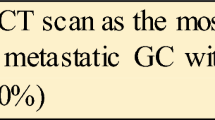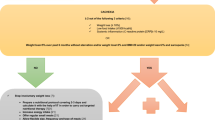Abstract
Cancer cachexia is defined as a state of involuntary weight loss, attributed to altered body composition with muscle mass loss and/or loss of adiposity. Identifying the association between cancer cachexia and outcomes may pave the way for novel agents that target the cancer cachexia process. Clinical parameters for measurement of cancer cachexia are needed. We conducted a single-institution retrospective analysis that included 86 NHL patients with the aim of identifying an association between cancer cachexia and outcomes in aggressive lymphomas using the cachexia index (CXI) suggested by Jafri et al. (Clin Med Insights Oncol 9:87–93, 15). Impact of cachexia factors on progression-free survival (PFS) and overall survival (OS) were assessed using log-rank test and Cox proportional hazards regression. Patients were dichotomized around the median CXI into “non-cachectic” (CXI ≥49.8, n = 41) and “cachectic” (CXI <49.8, n = 40) groups. Cachectic patients had significantly worse PFS (HR 2.18, p = 0.044) and OS (HR = 4.05, p = 0.004) than non-cachectic patients. Cachexia as defined by the CXI is prognostic in aggressive lymphomas and implies that novel therapeutic strategies directed at reversing cachexia may improve survival in this population.

Similar content being viewed by others
References
Shipp MA (1994) Prognostic factors in aggressive non-Hodgkin’s lymphoma: who has “high-risk” disease? Blood 83(5):1165–1173
Evans WJ, Morley JE, Argilés J et al (2008) Cachexia: a new definition. Clin Nutr 27(6):793–799
Staal-van den Brekel AJ, Dentener MA, Schols AM, Buurman WA, Wouters EF (1995) Increased resting energy expenditure and weight loss are related to a systemic inflammatory response in lung cancer patients. J Clin Oncol 13(10):2600–2605
Kuroda K, Nakashima J, Kanao K et al (2007) Interleukin 6 is associated with cachexia in patients with prostate cancer. Urology 69(1):113–117
Demetrius LA, Coy JF, Tuszynski JA. (2010) Cancer proliferation and therapy: the Warburg effect and quantum metabolism. Theor Biol Med Model. 7:2. doi:10.1186/1742-4682-7-2
Fredrix EW, Soeters PB, Wouters EF, Deerenberg IM, von Meyenfeldt MF, Saris WH (1990) Energy balance in relation to cancer cachexia. Clin Nutr 9(6):319–324
Petruzzelli M, Wagner EF (2016) Mechanisms of metabolic dysfunction in cancer-associated cachexia. Genes Dev 30(5):489–501
Falconer JS, Fearon KC, Plester CE, Ross JA, Carter DC (1994) Cytokines, the acute-phase response, and resting energy expenditure in cachectic patients with pancreatic cancer. Ann Surg 219(4):325–331
Ohnuma T. 2003 Manifestations of Cachexia. Holland-Frei Cancer Medicine. Hamilton
Project TIN-HsLPF (1993) A predictive model for aggressive non-Hodgkin’s lymphoma. The international non-Hodgkin’s lymphoma prognostic factors project. N Engl J Med 329:987–994
Perry AM, Alvarado-Bernal Y, Laurini JA et al (2014) MYC and BCL2 protein expression predicts survival in patients with diffuse large B-cell lymphoma treated with rituximab. Br J Haematol 165(3):382–391
Lenz G, Wright G, Dave SS et al (2008) Lymphoma/leukemia molecular profiling project. Stromal gene signatures in large-B-cell lymphomas. N Engl J Med 359(22):2313–2323
Uddin S, Bu R, Ahmed M, Hussain AR, Ajarim D, Al-Dayel F et al (2010) Leptin receptor expression and its association with PI3K/AKT signaling pathway in diffuse large B-cell lymphoma. Leukemia & Lymphoma 51(7):1305–1314
Carbone A, Gloghini A, Kwong Y-L, Younes A (2014) Diffuse large B cell lymphoma: using pathologic and molecular biomarkers to define subgroups for novel therapy. Ann Hematol 93(8):1263–1277
Jafri SH, Previgliano C, Khandelwal K, Shi R (2015) Cachexia index in advanced non-small-cell lung cancer patients. Clin Med Insights Oncol 9:87–93
Hans CP, Weisenburger DD, Greiner TC et al (2004) Confirmation of the molecular classification of diffuse large B-cell lymphoma by immunohistochemistry using a tissue microarray. Blood 103:275–282
Prado CM, Sawyer MB, Ghosh S et al (2013) Central tenet of cancer cachexia therapy: do patient with advanced cancer have exploitable anabolic potential? Am J Clin Nutr 98:1012–1019
Camus V, Lanic H, Kraut J et al (2014) Prognostic impact of fat tissue loss and cachexia assessed by computed tomography scan in elderly patients with diffuse large B-cell lymphoma treated with immunochemotherapy. Eur J Haematol 93(1):9–18
Lanic H, Kraut-Tauzia J, Modzelewski R, Clatot F, Mareschal S, Picquenot JM, Stamatoullas A, Leprêtre S, Tilly H, Jardin F (2014) Sarcopenia is an independent prognostic factor in elderly patients with diffuse large B-cell lymphoma treated with immunochemotherapy. Leuk Lymphoma 55(4):817–823
Gupta D, Lis CG (2010) Pretreatment serum albumin as a predictor of cancer survival: a systematic review of the epidemiological literature. Nutr J 9:69
Lin GN, Peng JW, Liu PP, Liu DY, Xiao JJ, Chen XQ (2014) Elevated neutrophil-to-lymphocyte ratio predicts poor outcome in patients with advanced non-small-cell lung cancer receiving first-line gefitinib or erlotinib treatment. Asia Pac J Clin Oncol. doi:10.1111/ajco.12273. [Epub ahead of print]
Skibola CF, Curry JD, Nieters A (2007 Jul) Genetic susceptibility to lymphoma. Haematologica 92(7):960–969
Charbonneau B, Maurer MJ, Ansell SM et al (2012) Pretreatment circulating serum cytokines associated with follicular and diffuse large B-cell lymphoma: a clinic-based case-control study. Cytokine 60(3):882–889
Bonetto A, Aydogdu T, Jin X et al (2012) JAK/STAT3 pathway inhibition blocks skeletal muscle wasting downstream of IL-6 and in experimental cancer cachexia. Am J Physiol Endocrinol Metab 303(3):E410–E421
Bonetto A, Penna F, Aversa Z et al (2013) Early changes of muscle insulin-like growth factor-1 and myostatin gene expression in gastric cancer patients. Muscle Nerve 48(3):387–392
Karmali R, Dalovisio A, Borgia JA et al (2015) All in the family: clueing into the link between metabolic syndrome and hematologic malignancies. Blood Rev 29(2):71–80
Karmali R, Paganessi LA, Frank RR, Jagan S, Larson ML, Venugopal P, Gregory SA, Christopherson KW 2nd (2013) Aggressive disease defined by cytogenetics is associated with cytokine dysregulation in CLL/SLL patients. J Leukoc Biol (1):161–70
Vishwamitra D, Shi P, Wilson D et al (2011) Expression and effects of inhibition of type 1 insulin-like growth factor receptor tyrosine kinase in mantle cell lymphoma. Heamatolgica 96(6):871–880
Oliveira AG, Gomes-Marcondes MC (2016) Metformin treatment modulates the tumour-induced wasting effects in muscle protein metabolism minimising the cachexia in tumour-bearing rats. BMC Cancer 16:418. doi:10.1186/s12885-016-2424-9
Author information
Authors and Affiliations
Corresponding author
Ethics declarations
Conflict of interest
The authors declare that they have no conflict of interest.
Rights and permissions
About this article
Cite this article
Karmali, R., Alrifai, T., Fughhi, I.A.M. et al. Impact of cachexia on outcomes in aggressive lymphomas. Ann Hematol 96, 951–956 (2017). https://doi.org/10.1007/s00277-017-2958-1
Received:
Accepted:
Published:
Issue Date:
DOI: https://doi.org/10.1007/s00277-017-2958-1




